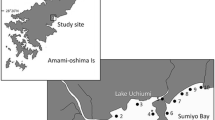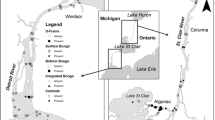Abstract
The round goby, Apollonia melanostoma, a molluscivore specialist, was introduced to the Great Lakes in the early 1990s and rapidly expanded its distribution, especially in Lake Erie. Adult round goby morphology suggests low dispersal and migration potential due to the lack of a swim bladder and benthic life style. Given that the larval stage occurs inside the benthic egg, and juveniles have adult morphologies, it has been suspected that dispersal and invasion potential is low for early life stages also. However, we identified early juvenile round gobies in the nocturnal pelagic in Lake Erie and thus we conducted a sampling study to determine the extent to which this life stage uses the nocturnal pelagic. Replicate ichthyoplankton samples were collected at 3-h intervals (1900–0700 h) at three depths (2 m, 5 m, 8 m) in western Lake Erie (water depth = 10 m) in July and August 2002 and June 2006. Early juvenile round gobies (6–23 mm TL) were present almost exclusively in the nocturnal samples (2200 h, 0100 h, 0400 h) with peak densities approaching 60 individuals per 100 m3 of water sampled. Nocturnal density was also significantly greater at 8-m depth versus 2-m and only the smallest fish (6–8 mm TL) migrated to the surface (2-m). Analyses of diet clearly demonstrated that these fish are foraging on plankton at night and thus may not be light limited for foraging in ship ballast tanks. In ships that take on thousands of tonnes of water for ballast, nocturnal ballasting could easily result in transport of thousands of young round gobies at a time. Additionally, within-lake dispersal at this lifestage is likely common and may facilitate downstream passage across barriers designed to limit range expansion.



Similar content being viewed by others
References
Anholt BR, Werner EE (1995) Interaction between food availability and predation mortality mediated by adaptive behavior. Ecology 76:2230–2234. doi:10.2307/1941696
Appenzeller AR, Leggett WC (1995) An evaluation of light-mediated vertical migration of fish based on hydroacoustic analysis of the diel vertical movements of rainbow smelt (Osmerus mordax). Can J Fish Aquat Sci 52:504–511. doi:10.1139/f95-051
Beletsky D, Saylor JH, Schwab DJ (1999) Mean circulation in the Great Lakes. J Great Lakes Res 25:78–93
Brett JR (1971) Energetic responses of salmon to temperature. A study of some thermal relations in the physiology and freshwater ecology of sockeye salmon (Oncorhynchus nerka). Am Zool 11:99–113
Campana SE, Neilson JD (1985) Microstructure of fish otoliths. Can J Fish Aquat Sci 42:1014–1032. doi:10.1139/f85-127
Charlebois PM, Marsden JE, Goettel RG, Wolfe RK, Jude DJ, Rudnika S (1997) The round goby, Neogobius melanostomus (Pallas), a review of European and North American literature. Illinois-Indiana Sea Grant Program and Illinois Nautral History Survey. INHS Special Publication No. 20, 76 pp
Charlebois PM, Corkum LD, Jude DJ, Knight C (2001) The round goby (Neogobius melanostomus) invasion: current research and future needs. J Great Lakes Res 27:263–266
Chesson J (1978) Measuring preference in selective predation. Ecology 59:211–215. doi:10.2307/1936364
Clark CW, Levy DA (1988) Diel vertical migrations by juvenile sockeye salmon and the antipredation window. Am Nat 131:271–290. doi:10.1086/284789
Dillon AK, Stepien CA (2001) Genetic and biogeographic relationships of the invasive round (Neogobius melanostomus) and tubenose (Proterorhinus marmoratus) gobies in the Great Lakes versus Eurasian populations. J Great Lakes Res 27:267–280
Dougherty JD, Moore WS, Ram JL (1996) Mitochondrial DNA analysis of round goby (Neogobius melanostomus) and tubenose goby (Proterorhinus marmoratus) in the Great Lakes basin. Can J Fish Aquat Sci 53:474–480. doi:10.1139/cjfas-53-3-474
Dubs DOL, Corkum LD (1996) Behavioral interactions between round gobies (Neogobius melanostomus) and mottled sculpins (Cottus bairdi). J Great Lakes Res 22:838–844
Eggers DM (1978) Limnetic feeding behavior of juvenile sockeye salmon in Lake Washington and predator avoidance. Limnol Oceanogr 23:1114–1125
Fuiman LA, Werner RG (2002) Fishery science. Blackwell Science, Malden, 326 pp
Groves RH, Burdon JJ (1986) Ecology of biological invasions. Cambridge University Press, Cambridge
Hall DJ, Werner EE, Gilliam JF, Mittelbach GG, Howard D, Doner CG (1979) Diel foraging behavior and prey selection in the golden shiner (Notemigonus chrysoleucas). J Fish Res Board Canada 36:1029–1039
Hensler SR, Jude DJ (2007) Diel vertical migration of Round Goby larvae in the Great Lakes. J Great Lakes Res 33:295–302. doi:10.3394/0380-1330(2007)33[295:DVMORG]2.0.CO;2
Hutchinson GE (1967) A treatise on limnology. Wiley, New York
Janssen J, Brandt SB (1980) Feeding ecology and vertical migration of adult alewives (Alosa pseudoharengus) in Lake Michigan. Can J Fish Aquat Sci 37:177–184. doi:10.1139/f80-023
Jude DJ, Reider RH, Smith GR (1992) Establishment of Gobiidae in the Great Lakes basin. Can J Fish Aquat Sci 49:416–421. doi:10.1139/f92-047
Jude DJ, Janssen J, Crawford G (1995) Ecology, distribution, and impact of the newly introduced round and tubenose gobies in the biota of the St. Clair and Detroit rivers. In: Munawar M, Edsall T, Leach J (eds) The Lake Huron ecosystem: ecology, fisheries, and management. Ecovision World Monograph Series, S. P. B. Academic Publishing, The Netherlands, pp 447–460
Kingsford MJ (2001) Diel patterns of abundance of presettlement reef fishes and pelagic larvae on a coral reef. Mar Biol (Berl) 138:853–967. doi:10.1007/s002270000455
Kovacik TL (1972) Information on the velocity and flow pattern of Detroit River water in western Lake Erie revealed by an accidental salt spill. Ohio J Sci 72:81–86
Logachev VS, Mordvinov YE (1979) Swimming speed and activity of larvae of round goby and some predatory crustaceans of the Black Sea. Biol Morya 3:77–80
MacInnis AJ, Corkum LD (2000) Fecundity and reproductive season of the round goby Neogobius melanostomus in the upper Detroit River. Trans Am Fish Soc 129:136–144. doi:10.1577/1548-8659(2000)129<0136:FARSOT>2.0.CO;2
MacIsaac HJ, Robbins TC, Lewis MA (2002) Modeling ships’ ballast water as invasion threats to the Great Lakes. Can J Fish Aquat Sci 59:1245–1256. doi:10.1139/f02-090
Mcllwain JL (2003) Fine-scale temporal and spatial patterns of larval supply to a fringing reef in Western Australia. Mar Ecol Prog Ser 252:207–222. doi:10.3354/meps252207
Mills EL, Ready RC, Jahncke M, Hanger CR, Trowbridge C (1984) A gastric evacuation model for young yellow perch, Perca flavescens. Can J Fish Aquat Sci 41:513–518. doi:10.1139/f84-061
Mills EL, Leach JH, Carlton JT, Secor CL (1994) Exotic species and the integrity of the Great Lakes. Bioscience 44:666–676. doi:10.2307/1312510
Mora C, Sale PF (2002) Are populations of coral reef fish open or closed? Trends Ecol Evol 17:422–428. doi:10.1016/S0169-5347(02)02584-3
Moyle PB, Cech JJJ (2000) Fishes—an introduction to ichthyology. Prentice Hall, Upper Saddle River, 612 pp
Nalepa TF, Schloesser DW (1993) Zebra mussels: biology, impacts, and control. Lewis, Boca Raton
Neilson JD, Perry RI (1990) Diel vertical migrations of marine fishes: an obligate or facultative process? Adv Mar Biol 26:115–168. doi:10.1016/S0065-2881(08)60200-X
Pedersen BH (1984) The intestinal evacuation rates of larval herring (Clupea harengus) predating on wild plankton. Dana 3:21–30
Persson L (1979) The effects of temperature and different food organisms on the rate of gastric evacuation in perch (Perca fluviatilis). Freshw Biol 9:99–104. doi:10.1111/j.1365-2427.1979.tb01493.x
Radtke RL, Kinzie RA III, Shafer DJ (2001) Temporal and spatial variation in length of larval life and size at settlement of the Hawaiian amphidromous goby. J Fish Biol 59:928–938
Ray WJ, Corkum LD (2001) Habitat and site affinity of the Round Goby. J Great Lakes Res 27:329–334
Ricciardi A (2001) Facilitative interactions among aquatic invaders: is an “invasional meltdown” occurring in the Great Lakes? Can J Fish Aquat Sci 58:2513–2525. doi:10.1139/cjfas-58-12-2513
Ricciardi A, MacIsaac HJ (2000) Recent mass invasion of the North American Great Lakes by Ponto-Caspian species. Trends Ecol Evol 15:62–65. doi:10.1016/S0169-5347(99)01745-0
Ricciardi A, Rasmussen JB (1998) Predicting the identity and impact of future biological invaders: a priority for aquatic resource management. Can J Fish Aquat Sci 55:1759–1765. doi:10.1139/cjfas-55-7-1759
Schloesser DW, Nalepa TF, Mackie GL (1996) Zebra mussel infestation of unionid bivalves (Unionidae) in North America. Am Zool 36:300–310
Simberloff D, Von Holle B (1999) Positive interactions of nonindigenous species: invasional meltdown? Biol Invasions 1:21–32. doi:10.1023/A:1010086329619
Simonovic P, Paunovic M, Popovic S (2001) Morphology, feeding, and reproduction of the round goby, Neogobius melanostomus (Pallas), in the Danube River Basin, Yugoslavia. J Great Lakes Res 27:281–289
Sponaugle S, Cowen RK (1994) Larval durations and recruitment patterns of two Caribbean gobies (Gobiidae): contrasting early life histories in demersal spawners. Mar Biol (Berl) 120:133–143
Stewart TW, Miner JG, Lowe RL (1998) Quantifying mechanisms for zebra mussel effects on benthic macroinvertebrates: organic matter production and shell generated habitat. J North Am Benthol Soc 17:81–94. doi:10.2307/1468053
Strayer DL (1999) Effects of alien species on freshwater mollusks in North America. J North Am Benthol Soc 18:74–98. doi:10.2307/1468010
Vanderploeg HA, Nalepa TF, Jude DJ, Mills EL, Holeck KT, Liebig JR et al (2002) Dispersal and emerging ecological impacts of Ponto-Caspian species in the Laurentian Great Lakes. Can J Fish Aquat Sci 59:1209–1228. doi:10.1139/f02-087
Werner EE, Hall DJ (1988) Ontogenetic habitat shifts in Bluegill: the foraging rate-predation risk trade-off. Ecology 69:1352–1366. doi:10.2307/1941633
Werner EE, Gilliam JF, Hall DJ, Mittelbach GG (1983) An experimental test of the effects of predation risk on habitat use in fish. Ecology 64:1540–1548. doi:10.2307/1937508
Wright D, O’Brien WJ, Vinyard GL (1980) Adaptive value of vertical migration: a simulation model argument for the predation hypothesis. In: Kerfoot WC (ed) Evolution and ecology of zooplankton communities. University Press of New England, Hanover, pp 138–147
Wurtsbaugh WA, Neverman D (1988) Post-feeding thermotaxis and daily vertical migration in a larval fish. Nature 333:846–848. doi:10.1038/333846a0
Zar JH (1999) Biostatistical analysis. Prentice Hall, Englewood Cliffs, NJ, 663 pp
Acknowledgments
This work was funded by the Lake Erie Protection Fund grant (SG185-02) to J. Miner and a research assistantship from the Department of Biological Sciences at Bowling Green State University to T. Hayden. Thanks to John Hageman and The Ohio State University Stone Lab for logistical support. We thank Chris Winslow, Edward Carruthers, James Bales, and Jennifer Hayden for helping with field collections and sample preparations. This manuscript benefited from critiques by Dan Wiegmann and anonymous reviewers.
Author information
Authors and Affiliations
Corresponding author
Rights and permissions
About this article
Cite this article
Hayden, T.A., Miner, J.G. Rapid dispersal and establishment of a benthic Ponto-Caspian goby in Lake Erie: diel vertical migration of early juvenile round goby. Biol Invasions 11, 1767–1776 (2009). https://doi.org/10.1007/s10530-008-9356-5
Received:
Accepted:
Published:
Issue Date:
DOI: https://doi.org/10.1007/s10530-008-9356-5




